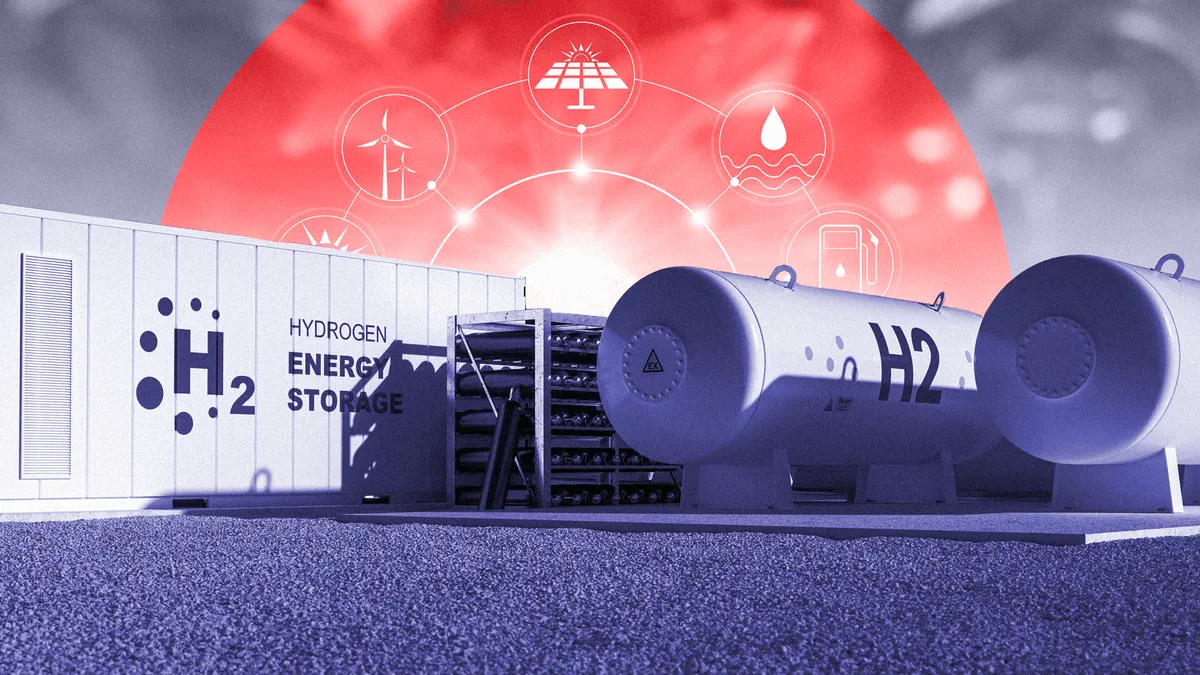Dive Brief:
- Green hydrogen remains too expensive to compete against conventional sources of hydrogen and other fuels, but the number of hydrogen projects underway has grown seven-fold in the past year as investors bank on the likelihood that hydrogen costs will fall, according to a report out last week from Wood Mackenzie.
- Green hydrogen may be cheaper than natural gas in at least 16 countries by 2050, and should be cheaper than conventional hydrogen extracted from fossil fuels by 2030 in most countries, according to Martin Tengler, lead hydrogen analyst for BloombergNEF.
- As-yet unexplored regulatory and technology options could cause the price of hydrogen to drop even further, according to Janice Lin, founder and president of the Green Hydrogen Coalition. “Clearly that’s not where costs are today,” Lin said, “but I think we’ve answered the question of 'is this even possible' — and the answer, I’m happy to report, is yes.”
Dive Insight:
Green hydrogen, which is produced by extracting hydrogen from water using electrolysis powered with renewable energy, remains too expensive to offer a financially viable alternative to fossil fuels, or even to more conventional sources of hydrogen. But multiple analyses completed in recent weeks suggest this too could change by the end of the decade.
Globally, more than 560 low-carbon hydrogen projects are now underway, although most are still in early stages of development, according to Wood Mackenzie. Those projects represent a total of 180 GW of total electrolyzer capacity; by comparison, global electrolyzer capacity was less than 200 MW in 2019, according to the firm’s latest report.
The growing scale of the industry and increased competition from new market entrants, coupled with greater automation and other improvements in technology, are poised to drive a rapid decline in the cost of hydrogen production, according to Wood Mackenzie. The cost of multiple kinds of electrolyzers are expected to fall dramatically over the next six to eight years, according to the report, with polymer electrolyzer membrane costs expected to fall 35-50% by 2025.
The effects for this transformation will be felt in some parts of the world sooner than others, according to Tengler. Based on analysis completed last month by BNEF, Tengler said green hydrogen could be cheaper than blue hydrogen — which is extracted from fossil fuels and paired with carbon capture to eliminate emissions — as early as 2023 in China. Much of the rest of the world should catch up by 2030, with green hydrogen costs dropping below those of fossil fuels by 2050 in the U.S. and 15 other countries, Tengler said.
China will lead the world’s progress toward low-cost green hydrogen on account of its access to cheap electrolyzers, which can be built in China for 75% less than in other countries on account of that nation’s large electrolyzer manufacturing capacity, high demand for hydrogen, low labor and materials costs and increasing automation. Brazil and Chile will be among the next countries where green hydrogen becomes cost competitive on account of cheap renewable energy and high prices for fossil fuels in those countries, Tengler said.
Tengler said the BNEF analysis assumed current policies remained in place and did not factor in a potential cost of carbon.
Other market policies could further reduce the cost of green hydrogen, according to Lin. Since launching an initiative to find pathways toward cost-competitive green hydrogen in the southwestern U.S. earlier this year, the Green Hydrogen Coalition has determined green hydrogen could near a target price of $1.50 per kg of delivered hydrogen by the end of this decade using today’s technologies and without government incentives. But policy change could further accelerate the price drop, either by increasing the rate at which the industry achieves scale, or through market reforms that could enable producers of green hydrogen to bill for ancillary services provided to the grid.
“I think we all need to put our seatbelts on,” Lin said, “because things are about to get super exciting for clean hydrogen and green hydrogen in the U.S.”














